Middle East
Fear, pain, and a little hope: Volunteer doctors in Gaza | Israel-Palestine conflict News
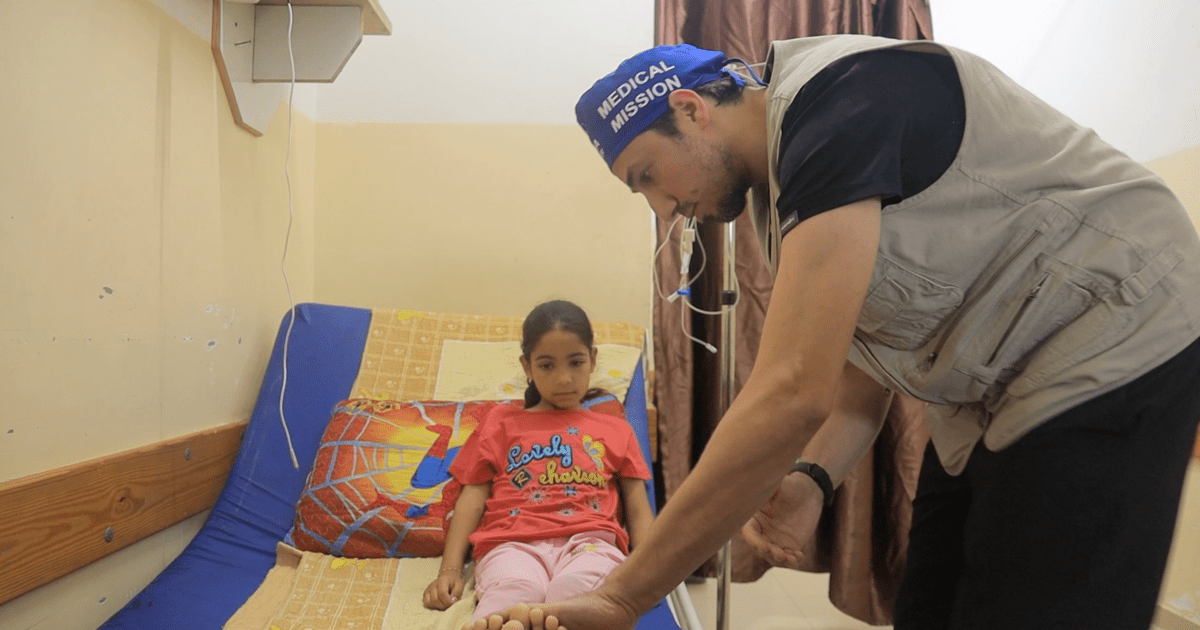
In the Nasser Medical Complex in Gaza’s Khan Younis, a volunteer doctor breaks down as he speaks of the things he has seen during his mission here.
It is impossible to get over the scenes of starving, shocked, and injured children, thoracic surgeon Ehab Massad says.
“The sight of a child standing at the door, bewildered because they have lost their entire family in a bombing, I could never forget that, ever,” he adds in a faltering voice as tears fill his eyes.
‘It will never feel like enough’
Massad is a member of a medical mission by the Rahma Worldwide organisation, one of four doctors working in Qatar to have joined.
“I feel like no matter what we do for [the people of Gaza], it will never feel like enough,” he says.
“[However] the helpless feeling of being outside Gaza and watching the news is gone now; at least I feel like I’m doing my part.”
It’s a feeling echoed by the three other doctors to whom Al Jazeera spoke. Orthopaedic surgeon Anas Hijjawi described a long line of doctors who had signed up for medical missions to Gaza, some of whom had to wait up to five months for a spot on a mission to open up.
Dr Diyaa Rachdan, an ophthalmic surgeon, struggles to keep his voice steady as he tells Al Jazeera that Tuesday was the last day of the mission and the doctors would be heading back to their respective hospitals the next day.
“But I am hoping that there will be more, longer trips to Gaza in the future,” he adds.
Their work in Gaza is not easy, but that is not the reason these doctors are sad to be leaving their mission behind. On the contrary, every day is a struggle as they try to cope with a volume of deaths, illnesses and injuries they simply do not have the equipment to address.
Israel has often prevented the entry of hospital supplies into Gaza during the course of its nearly 19-month-long war on the besieged enclave. Medical missions are not allowed to bring anything in with them.
So, the doctors struggle on with the equipment they can find, sometimes reusing “disposable” medical implements over and over, despite the danger that poses, because there is simply no other choice, Dr Rachdan says.
At the back of their minds, several doctors tell Al Jazeera, is always the thought that people in Gaza die of wounds and illnesses that would be easily treated in any other hospital that has adequate supplies.
![Dr Almanaseer reassures a young patient about the burns covering her body and face [Screengrab/Al Jazeera Mubasher]](https://www.aljazeera.com/wp-content/uploads/2025/04/Screenshot-2025-04-30-at-4.50.35%E2%80%AFPM-1746021548.png?w=770&resize=770%2C481&quality=80)
“Sometimes we can’t cover a patient or take precautions to preserve the sterility of an operating room,” Dr Hijjawi says.
“Sometimes I don’t have the right size metal plates or screws that I need to mend a limb. I’ve had to use the wrong size item … just to get them better enough that they could, some day, travel for more treatment.”
The things that happen to people in war
While doctors coming into Gaza have often followed developments there closely before arrival, nothing, they tell Al Jazeera, could have prepared them for the level of destruction the people of Gaza have to cope with.
“Words can’t describe the pain people are in here, or the level of exhaustion of the medical teams. They’ve been working nearly around the clock for a year and a half now, despite their own personal pain and tragedies,” says the fourth Qatar-based volunteer, urology consultant Mohammad Almanaseer.
There’s a tentativeness in Dr Almanaseer’s voice as he speaks of the case that has impacted him the most deeply, the story of a little boy of about two years old who was brought into the emergency room after Israel had bombed him and his family.
“The usual resuscitation attempts were made with him, but he needed immediate surgery. I was in the operating room, assisting the paediatric surgeon, but it became clear to us that the child probably wouldn’t survive.”
The child died the next morning.
“He was the same age as my son, and even had the same name. Kinan, little Kinan, may God receive you and your mother, who was killed in the same bombing, by his side.”
Injuries as extreme and urgent as Kinan’s are what the medical teams deal with day in and day out, resulting in a large swath of patients who need less urgent care and who keep getting pushed down the list.
Like the patients who have been waiting for months or years for cataract surgery, some of whom were helped by Dr Rachdan during this mission.
The people of Gaza have been forced to carry on throughout the genocidal war on their existence. This strength has inspired a sort of bewildered regard among the visiting volunteer doctors.
Dr Hijjawi tells of an afternoon chat with an operating room nurse who was explaining how he struggles to get to work every day and how he says a final farewell to his wife and children every day, because he never knows what may happen to any of them.

“Then, we heard ambulances coming in,” Dr Hijjawi continues, “and we went to muster in the emergency room. Suddenly, the OR nurse came running past us, desperately asking for an ambulance to go to his house with him because he had heard it had been bombed.
“It took some time … but they finally went out and came back with his parents, who had been killed, and the rest of his family, who had injuries among them. And, you know what? Just two days after this happened to him, he’s here, he’s upstairs working.”
The silence of the shocked
All four doctors seem to have a soft spot for their paediatric patients. It is the children’s pain that affects them the most, and it is their suffering that they will take away with them in their memories.
Al Jazeera follows Dr Almanaseer on his rounds as he visits a young girl in intensive care. She is recovering from severe burns on much of her face and body. In quiet tones, she asks him about whether she will be left with big scars from the burns.
The doctor answers her quietly and seriously, taking time to talk to her until it seems like she’s reassured for today.
Dr Hijjawi is also on his rounds, speaking to a little girl, gently examining her leg and asking her to “lift both feet off the bed for me”. Then he asks a little boy to wiggle his toes so he can check on how he’s healing.
Next is a young girl lying under a recovery blanket in a room on her own. Her right arm is bandaged, which is what he’s there to look at.
He squats on the floor near her bed and moves her arm, then each of her fingers. He’s concerned because she seems to have lost sensation in two fingers and feels the problem will have to be explored surgically, as he tells a concerned relative.
The children are quiet, wide-eyed, doing as they’re told and not saying much else.
“There’s so much they’re dealing with,’ Hijjawi says. “Being in the hospital is scary, but on top of that, so many of them are just lying there waiting, hoping, for someone to visit them – a parent or grandparent or sibling. Some of them don’t know who’s left alive from their family outside the hospital walls.
“Add all that to their physical pain, yes, they are very quiet for very long periods, or their minds seem to wander,” he says quietly.
Dr Rachdan is holding fast to one memory of Gaza’s children that he seems to want to preserve as he gets ready to leave: “One thing that I don’t think I will ever forget is the sight of the children in Gaza who continue playing, despite the destruction.
“They make paper aeroplanes, play ball, despite the tragedy they are surrounded by. I will always remember that.”
Middle East
Nearly 290,000 Gaza children on ‘the brink of death’ amid Israeli blockade | Israel-Palestine conflict News
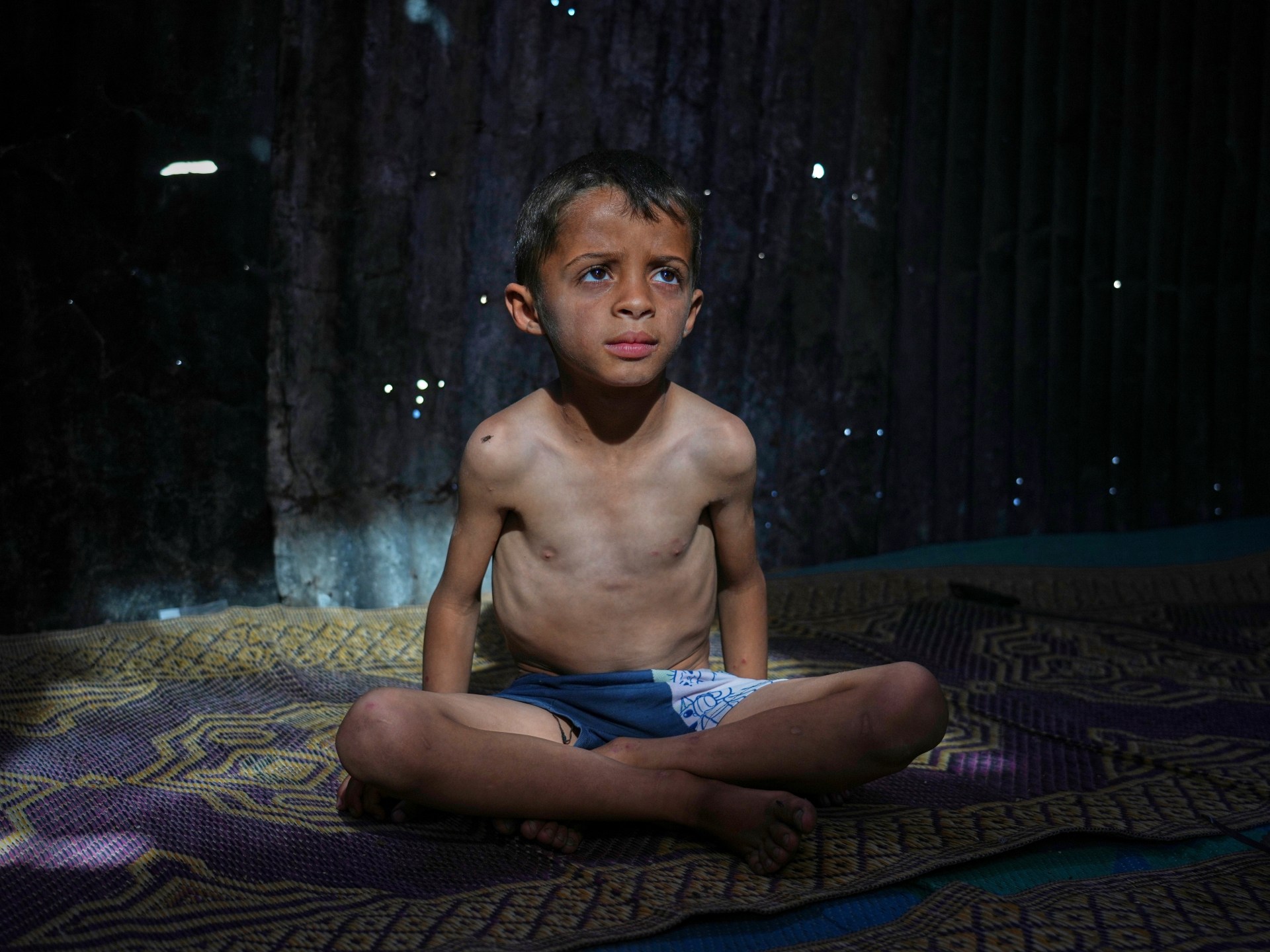
More than 3,500 children below the age of five years “face imminent death by starvation”, Gaza’s Government Media Office (GMO) has said, adding that some 70,000 children are being hospitalised in the enclave due to severe malnutrition amid more than two months of total Israeli blockade.
“Under this systematic blockade, more than 3,500 children under the age of five face imminent death by starvation, while approximately 290,000 children are on the brink of death,” the GMO statement on Telegram said on Sunday.
“At a time when 1.1 million children daily lack the minimum nutritional requirements for survival, this crime is being perpetrated by the ‘Israeli’ occupation using starvation as a weapon, amid shameful international silence,” it added.
At least 57 Palestinians have starved to death, causing global outrage, but that has failed to convince Israel to allow entry of aid into the enclave of 2.3 million people.
A shortage of food and supplies has driven the territory towards starvation, according to aid agencies. Supplies to treat and prevent malnutrition are depleted and quickly running out as documented cases of malnutrition rise.
The price of what little food is still available in the market is unaffordable for most in Gaza, where the United Nations says more than 80 percent of the population relies on aid.
Aid groups and rights campaigners have accused Israel of using starvation as a weapon of war.
Israel, for its part, insists the blockade is necessary to pressure Hamas to release the captives it still holds. Of the 59 captives still in Gaza, 24 are believed to be alive.
Israel’s war on Gaza has killed at least 52,495 Palestinians and wounded 118,366, according to Gaza’s Ministry of Health. The GMO updated the death toll to more than 61,700, saying thousands of people missing under the rubble are presumed dead.
Middle East
Are Yemen’s non-Houthi groups seeking US support to attack the Houthis? | Houthis
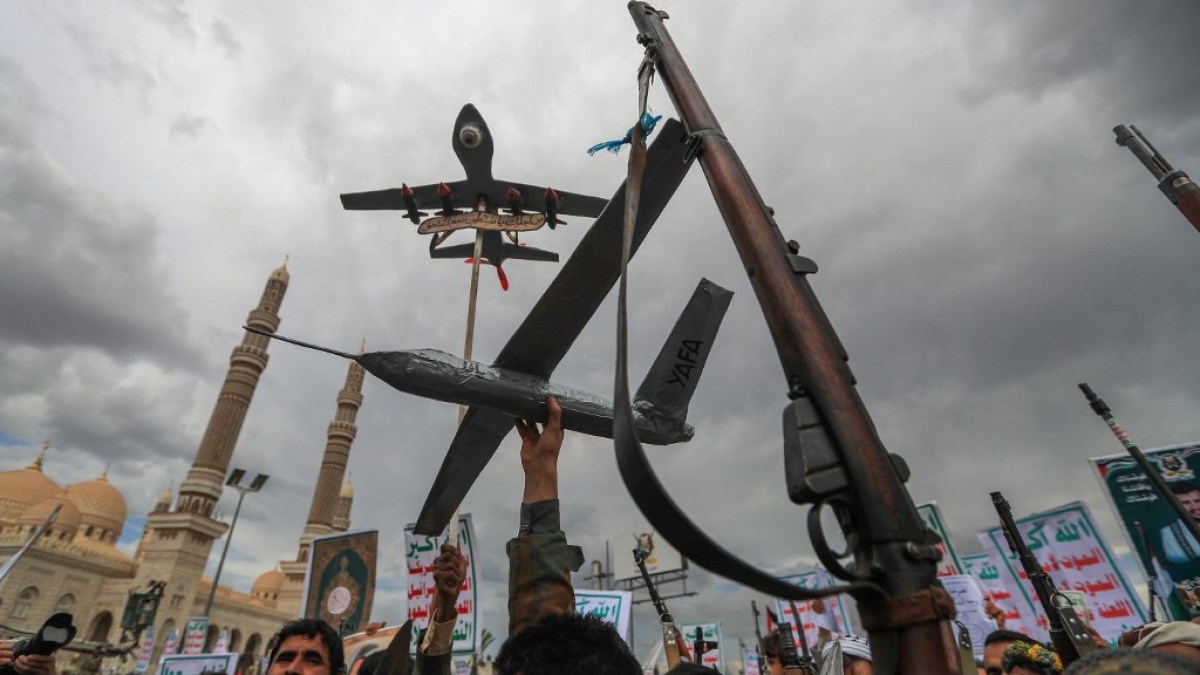
Anti-Houthi factions in Yemen could be vying for US support to attack the movement’s territory, analysts and experts told Al Jazeera, following intensified air strikes on Houthi targets by the United States.
The war in Yemen has largely been frozen for the last three years. Still, groups aligned with the Yemeni government have started signalling that they could launch operations against areas controlled by the pro-Iranian Houthis, including the crucial port of Hodeidah.
A similar campaign on Hodeidah, a critical entry point for food and goods on the Red Sea coast, seemed imminent in 2018, only to be aborted after intervention from the United Nations and the international community, who feared a humanitarian disaster in Yemen.
But experts and analysts expressed doubt that an attack by anti-Houthi groups on their domestic rival would be successful, despite some likening it to the offensive that unseated another Iran ally, former Syrian President Bashar al-Assad, in late 2024.

“Pro-ROYG [Republic of Yemen Government] voices have been asserting that ground operations against the Houthis – in Hodeidah and potentially elsewhere – are imminent,” Hannah Porter, an independent Yemen analyst, told Al Jazeera.
“My impression so far is that these comments are just meant to garner external support from the US or Saudi [Arabia] for a takeover of Hodeidah.”
Vying for US support
The Houthis, or Ansar Allah as they are officially known, marched into and took over the Yemeni capital Sanaa in 2014. Soon after, a Saudi Arabian-led coalition intervened on behalf of Yemen’s internationally recognised government to fight the Houthis.
Anti-Houthi forces achieved some success in the early years of the war, but the failed Hodeidah campaign seemed to slow their momentum, and the Houthis have largely been on top militarily since then.
Saudi Arabia announced in March 2022 that it would stop hostilities in Yemen, and a UN-brokered truce stopped much of the fighting the following month.
By then, the Houthis still controlled Sanaa and much of northwest Yemen, while various anti-Houthi groups held the key port city of Aden and much of southern and eastern Yemen.
The Yemeni government has undergone major changes in the past few years, with President Abd-Rabbu Mansour Hadi suddenly stepping down in 2022 and handing over power to an eight-member Presidential Leadership Council (PLC), which has, so far, proven ineffective.
PLC Prime Minister Ahmed Awad Bin Mubarak resigned on Sunday, claiming to have been blocked from fulfilling his duties, as reports circulated of conflicts between him and President Rashad al-Alimi and accusations of mission creep.
The PLC includes members who have previously fought against the Yemeni government. They include Aydarous al-Zubaidi, the head of the separatist Southern Transitional Council (STC), and Tareq Saleh, nephew of former President Ali Abdullah Saleh, a one-time ally of the Houthis.
But Houthi attacks on what they claim are Israeli-linked ships in the Red Sea, as well as attacks on Israel itself, have led to a bombing campaign against Yemen, and some anti-Houthi forces now see an opening.
“We’ve been seeing various anti-Houthi factions lobbying for US support since the start of the Gaza crisis,” Nick Brumfield, a Yemen expert, told Al Jazeera.
“Both the Yemeni government and the Southern Transitional Council have competitively sought to present themselves as the solution to the US’s need for a partner on the ground against the Houthis in Yemen.”

Plan versus reality
The Yemeni government has long emphasised that its ultimate goal is the defeat of the Houthis and an end to the group’s “coup” against the Yemeni state.
In early April, President al-Alimi spoke of the importance of national unity “to topple the coup”, adding that the “decisive hour” of the “battle for liberation” was drawing near.
Al-Alimi has not given any indication of when that battle against the Houthis would be, but forces under the umbrella of the Yemeni government may see the intensification of US air strikes under President Donald Trump’s administration.
The US claims the strikes targeted Houthi leaders and have significantly degraded Houthi capabilities. Houthi authorities say that at least 123 Yemenis have been killed in the strikes since they intensified in mid-March, many of them civilians.
Reporting from The Wall Street Journal (WSJ) and Bloomberg has claimed that discussions for an anti-Houthi ground operation, backed by the US, are under way.
The WSJ specifically mentioned that the United Arab Emirates had raised the plan with the US, but the UAE has denied any involvement, with Assistant Minister for Political Affairs Lana Nusseibeh calling them “wild unsubstantiated stories” on April 17.
The UAE officially withdrew its military forces from Yemen in 2019.

Tareq Saleh has been mentioned in news reports as a likely figure leading any anti-Houthi campaign on the Red Sea coast.
But, experts say, there has thus far been no noticeable mobilisation on the ground by anti-Houthi Yemeni armed groups.
“The PLC has been speaking about liberating Sanaa and such,” Raiman Al-Hamdani, a Yemen researcher with ARK, an international development company, told Al Jazeera.
“As far as I know, there has been little mobilisation towards this end. Whether they can is a very different story, especially with Saudi Arabia and the UAE no longer wanting to engage in war with the Houthis.”
After years of fighting, the Saudis and Houthis entered into ceasefire discussions in 2022, leaving anti-Houthi groups – including the Yemeni government – uncertain over their future and the Houthis further entrenched in power.
Al Jazeera reached out to the Yemeni government for comment on this story but received no response before publication.
Comfortable in the status quo
An advance on Sanaa, high up in the Yemeni mountains and closer to the Houthi heartland in Yemen’s far north, would be difficult for Yemeni government forces, and would involve a massive turnaround in fortunes, as well as turning Yemen’s most powerful tribes, many of whom currently back the Houthis.
The main target of any US-backed operation, however, would likely be Hodeidah, which lies on a coastal plain and whose population is less supportive of the Houthis. Losing Hodeidah, as well as other areas of the Red Sea coast, would still represent a significant loss for the Houthis and limit their ability to attack shipping on the vital sea route.
That would line up with the primary goal of the US to curtail the ability of the Houthis to attack regionally, even if the group were still able to launch missiles further afield.

But any effort to take Hodeidah would still likely require a fierce campaign, and thus far, no force – including the US – appears to be willing to fully back anti-Houthi forces militarily.
That is problematic for the anti-Houthi forces and potentially a non-starter, considering the Yemeni government’s inability to defeat the Houthis even when it had heavy military support from the Saudi-led coalition earlier in the war.
“The Houthis will throw all their weight behind defending Hodeidah,” Porter said. “Their port access is critical to their survival.”
She added that the Houthis were likely in a better military position to defend Hodeidah than any group attempting to advance on it.
“Honestly, I think the Republic of Yemen Government and the Presidential Leadership Council are not very invested in shifting the status quo,” Porter said.
“If there was a viable opportunity to take Hodeidah Port, then they would seize on that, but I don’t think they’ll have the support they need.”
Middle East
Sudan’s RSF carries out drone attack near Port Sudan airport: Army | News
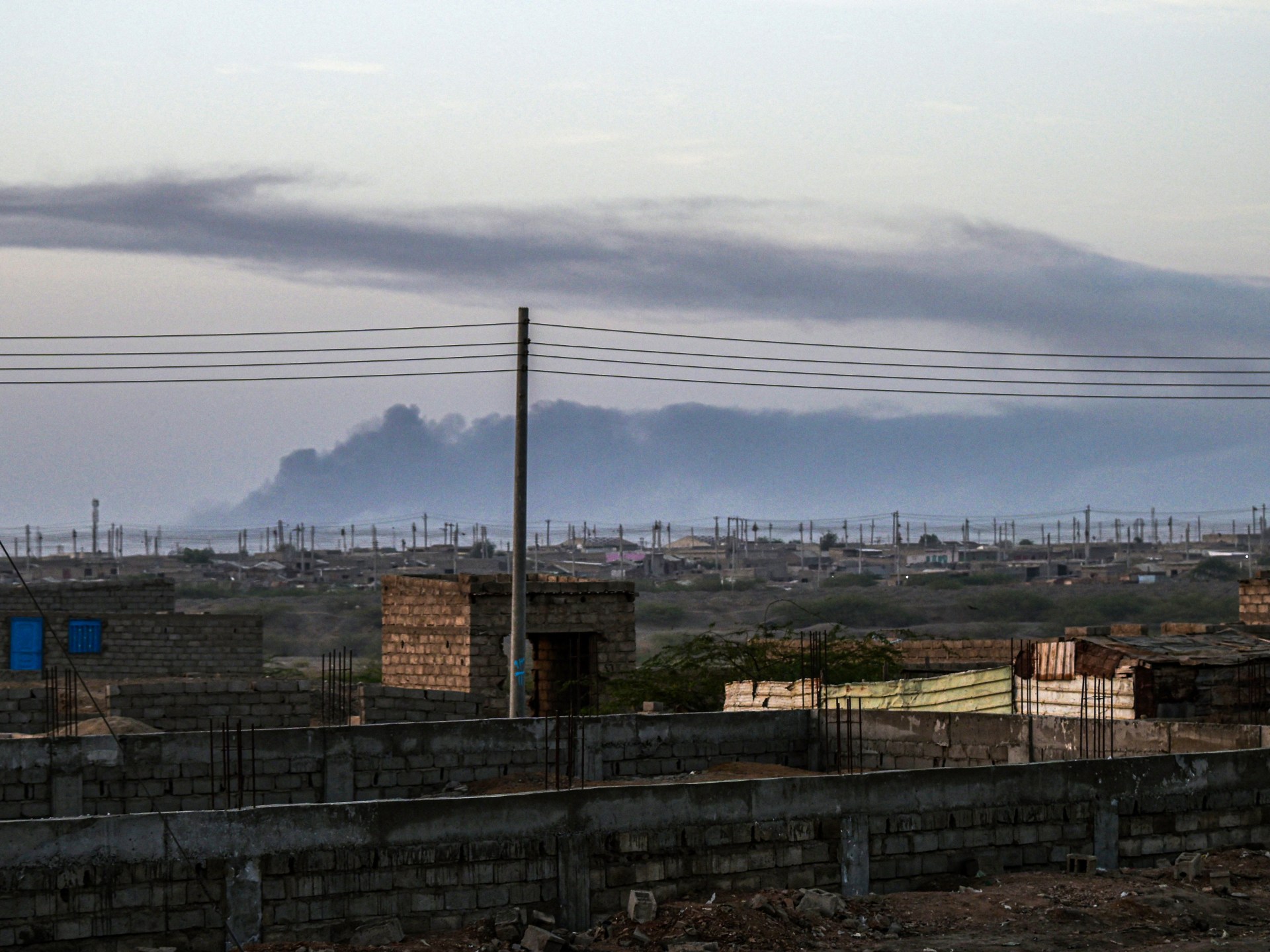
DEVELOPING STORYDEVELOPING STORY,
The army says an airbase, cargo warehouse and some civilian facilities were targeted in Port Sudan in the first RSF attack in the eastern city.
Sudan’s army says the paramilitary Rapid Support Forces (RSF) attacked a military airbase and other facilities in the vicinity of Port Sudan airport.
The army said on Sunday that the airbase was targeted using a drone, as well as a cargo warehouse and some civilian facilities, in the first attack in the eastern city by the RSF.
There are reports of some damage after drones hit an ammunition depot.
“Both the civilian and military airports are in the same place. What we know from residents in the port city is that five drones were launched by the RSF and targeted the airbase,” Al Jazeera’s Hiba Morgan said, reporting from the capital, Khartoum.
“There is a section of the airport that is for civilian flights, but there are military flights that land in the same airport. So, it’s not clear if the drones were targeting the military or civilian facilities or both,” she said.
“There are no reports of civilian casualties yet, and it’s not clear if the RSF was trying to target the fighter jet that was displayed in an air force show there on Saturday afternoon.”
A Sudanese passenger plane was redirected to Jeddah Airport after being unable to land at Port Sudan Airport, according to navigation data from Flight Radar.
The data showed that the plane took off from Dubai International Airport but had to change its route and make an emergency landing at King Abdulaziz International Airport. The plane performed a circular maneuver over the Red Sea before heading back towards Jeddah.
Sudan’s army and the RSF have been engaged in intense fighting since April 2023, with the war damaging the country’s infrastructure and displacing millions.
-

 Education2 days ago
Education2 days agoTrump says he will revoke Harvard’s tax-exempt status
-
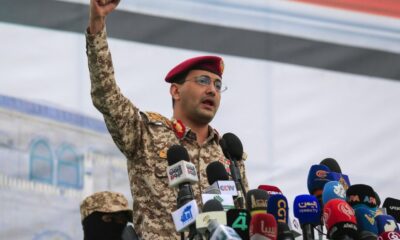
 Conflict Zones2 days ago
Conflict Zones2 days agoYemen’s Houthis launch missiles at Israel, army says it intercepts | Houthis News
-

 Europe2 days ago
Europe2 days agoPrince Harry says father, King Charles, no longer speaks to him but hopes to reconcile
-

 Africa2 days ago
Africa2 days agoFear and uncertainty grip Haitian workers in Texas meatpacking plants amid immigration crackdown
-

 Sports2 days ago
Sports2 days agoGregg Popovich steps down as San Antonio Spurs head coach and is moving to team’s front office as president
-
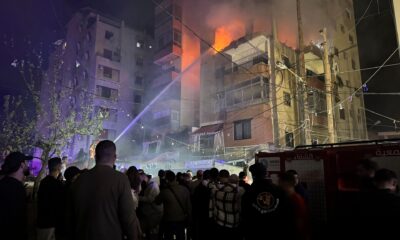
 Middle East2 days ago
Middle East2 days agoLebanon warns Hamas against attacks threatening nation’s security | Israel attacks Lebanon News
-

 Sports2 days ago
Sports2 days agoThe larger-than-life Bob Baffert is returning to the Kentucky Derby. The identity crisis he represents in racing never left.
-

 Europe2 days ago
Europe2 days agoCosta Rica shipwrecks, long thought to be pirate ships, were transporting enslaved people




